The Illusion of Simplicity

Don't let this home theater's classic design and clean lines fool you. It may look like a simple rectangular space that houses a high-end audio/video system, but closer inspection reveals that the real technological marvel is the room itself. A tremendous amount of planning, construction, and creativity went into the process of creating an acoustically optimized space that can serve as both a casual reading/viewing room and a thoroughly immersive home theater.
When the house was still in its design phase, the homeowner knew he wanted to incorporate a dedicated theater space, a room that could serve as a comfortable retreat. The architect suggested All Around Technology, based in Maryland. Tim Rooney and his team of architects, engineers, consultants, and installers were brought in before an ounce of concrete was poured to ensure that the desired space was built to the correct acoustic specifications.
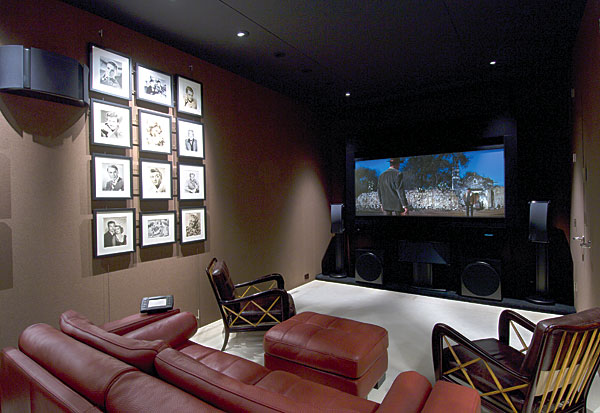
The homeowner, a successful theater producer, made only a few demands of the All Around Technology crew. As Rooney recalls, "He wanted the best picture he could have, and he wanted to display his photography collection on the walls." Those are pretty straightforward requests, right? The team would discover that meeting those requests would prove more challenging and ultimately more rewarding than they imagined.

Sound Theory and Practice
Let's begin with that collection of black-and-white Hollywood photos. In a normal room, you could hang them anywhere you wish, based solely on the desired aesthetic; however, a quick lesson in acoustics 101 teaches us that a home theater room needs diffusion and other acoustic treatment, particularly in the wall area, where art generally hangs. "For the homeowner, those photos really superceded everything else," Rooney explains. "If we couldn't find a way to put the acoustic treatment around them, he just wanted to hang them on the drywall." A quick glance at the end result may lead you to believe that's what ultimately happened, but there's a lot more to those brown walls than meets the eye.

The team began to address the issue even during the design phase. "We had to figure out how we were going to hang the pictures before they started building the house, because we needed to accommodate any extra wall thickness," Rooney tells us. "We had to solve all of the problems with the lighting, the seating, the screen location, and the pictures before construction." To aid in this process, they brought in acoustic expert Keith Yates to help with the room's modeling, and RPG Diffusor Systems' Tony DeAngelo to select the specific acoustic materials. "We designed the acoustic space with the parameter that the frequencies the pictures reflected would behave differently than the other frequencies."
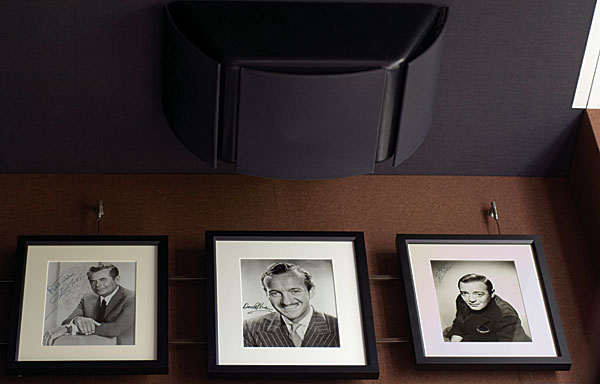
The walls might look like painted drywall, but look again. In fact, they are covered in stretch Guilford 701 acoustically transparent material that conceals a wide assortment of RPG acoustic panels. To tame ceiling reflections and minimize sound leakage into the closets and the master bathroom above, they created a second ceiling that would accommodate acoustic treatment and provide space to mount the light fixtures. In the meantime, Yates designed a front-stage riser that also served as a bass trap to tame bass output from the 7.2-channel speaker system. Beautiful white marble floors run throughout the home, and the team used the same marble around the theater's outer edges while laying carpet over absorptive material in the center of the floor.
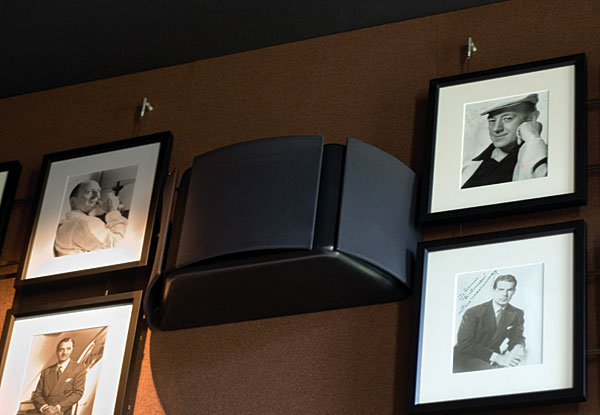
As for the photos themselves, they couldn't very well hang on the fabric walls, so All Around Technology hired one of the country's preeminent builders of custom museum displays to design and build a system of armatures to hold the entire collection. "Our criteria was that the owner had to be able to hang his own art on it," says Rooney, "and the art had to lock on it in such a way that a 3-year-old could climb on the structure and not knock it free." Peek behind this grid, and you'll see that the structure doesn't touch the wall except at the top and the bottom, where it's anchored via high-tensioned steel brackets meant to withstand even the most industrious 3-year-old.
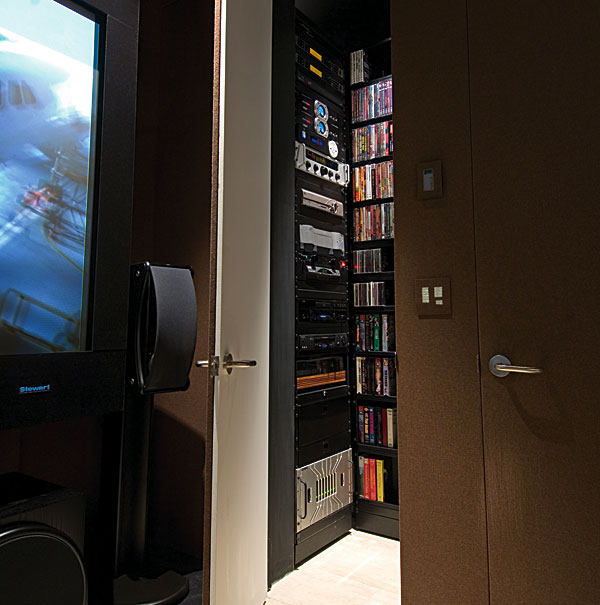
Final acoustic touches include locating the equipment in a separate room and customizing a silent, large-duct HVAC system, in which the vents are carved directly into the marble floor. The end result is a room that is extremely quiet without seeming acoustically dead. "It just sounds right," Rooney tells us. "We used more absorption than we usually would because of all the direct reflections, but the room acoustics are still good for conversation. You get the dedicated theater experience while still maintaining a sociable aspect."
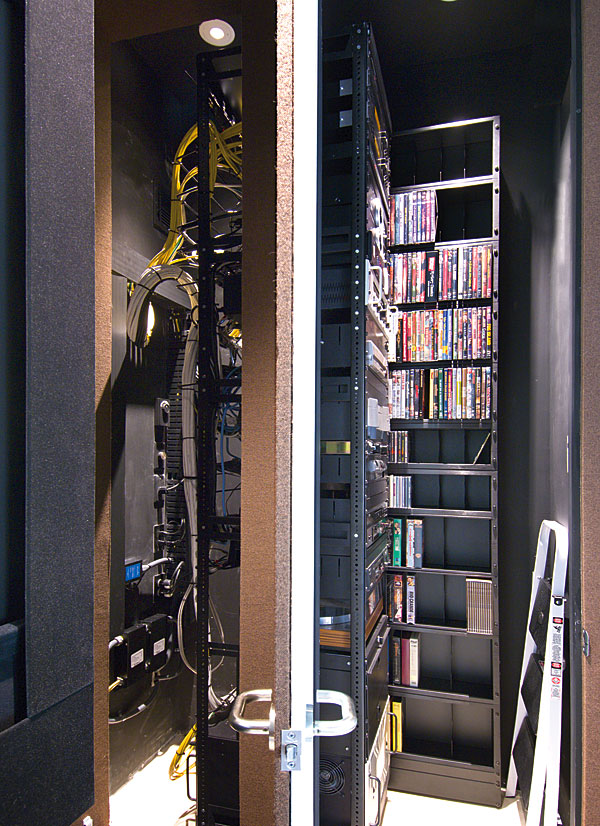
Simply the Best
To meet the homeowner's second request, that he get the best picture possible, Rooney knew they needed a video setup that was both accurate and engrossing. He describes the homeowner as "one of the only videophiles I've met who doesn't work in the industry. Eighty percent of what he watches is in black and white. Because of that, he's gotten quite good at seeing gray-scale anomalies."
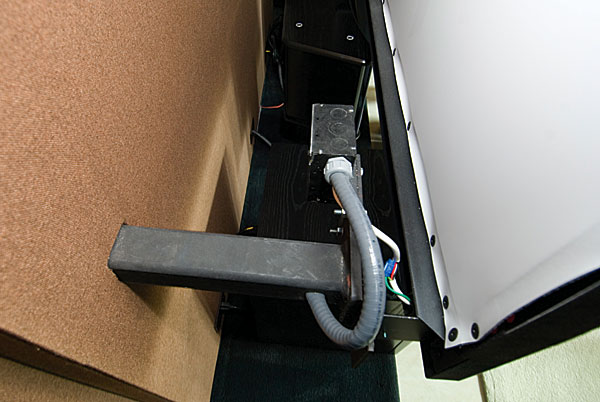
They went with a Runco VX-2 three-chip DLP projector, mating it with an 87-inch-wide Stewart screen that uses the Director's Choice four-way masking system. Because the owner didn't want to hide the screen and front speakers behind a wall, the team had to figure out how to hold people's attention on the viewing area, even in casual conditions with some lights turned on. This began with a floating-screen construction, in which a cantilever support structure, made of steel, holds the screen several inches from the wall. The surrounding elements—the all-black Revel Ultima speakers and B12 subwoofers, the black riser, the dark wall fabric, and the Lutron HomeWorks lighting system—contribute to the illusion that the video image is floating in darkness, even when the lights above the seating area are illuminated. This gives the homeowner the flexibility to enjoy a high-quality image under multiple lighting conditions.

For Rooney, the masking system is the crucial final step in the video system's overall impact. "People need to be educated as to why masking systems are important. The second the mask moves into place, the front of the room disappears. The experience goes from, 'I'm a movie on a screen,' to, 'I'm art. I'm a window into an alternate time and place.'" Luckily, this homeowner needed little convincing. "It wasn't a hard sell, because all of these old movies he watches are in strange formats, like 1.66:1. He wanted to be able to control the masking system to tailor it to the specific movie he's watching." The team programmed presets for standard aspect ratios into the Crestron control system but gave the homeowner direct access to the four-way masking controls so he can tweak to his heart's content.
The sources delivering that floating image include a Denon universal disc player, a VHS player, and three HD systems: HD cable, HD DISH Network, and HD DirecTV. Even with all of that high-definition content at his disposal, this lover of black-and-white films spends most of his time watching AMC, TCM, and old classics on DVD. It's only fitting. As his walls pay homage to the actors and actresses of a bygone era, his home theater system celebrates their achievements, proving that a high-quality video system isn't just for high-end sources. It should bring any source to life.
Yes, it all seemed so simple. A film buff wants a comfortable retreat where he can read, relax, and watch his favorite movies. What he got was a model of technical design that earned All Around Technology a 2006 CEDIA Electronic Lifestyles Award. In the end, Rooney attributes the project's success to the complete team effort. "Getting the acoustics package to harmonize with the architectural and design motifs for the room is always the biggest challenge. You have to make sure that the people responsible for making decisions about design, architecture, and building believe that room acoustics are important. That was the case here, and it turned out great."
Tim Rooney's Installation Checklist: 10 Steps to a High-Performance Theater
1) An informed and engaged customer
2) A builder, architect, and designer that buys into the process
3) Total darkness in the room
4) Acoustic isolation to adjoining spaces
5) A dedicated, low-noise HVAC system
6) Great lighting with scene control
7) Acoustic analysis and treatment in the room
8) Lots of dedicated, low-noise power
9) A simple user interface
10) Final calibration of the room acoustics, audio, video, HVAC, and lighting
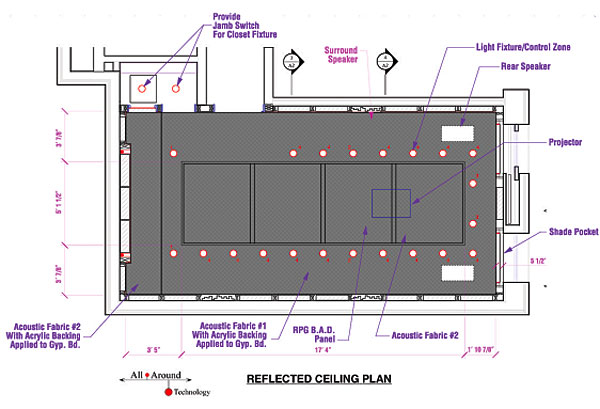
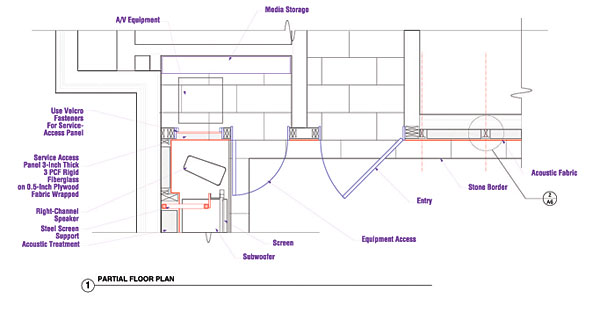
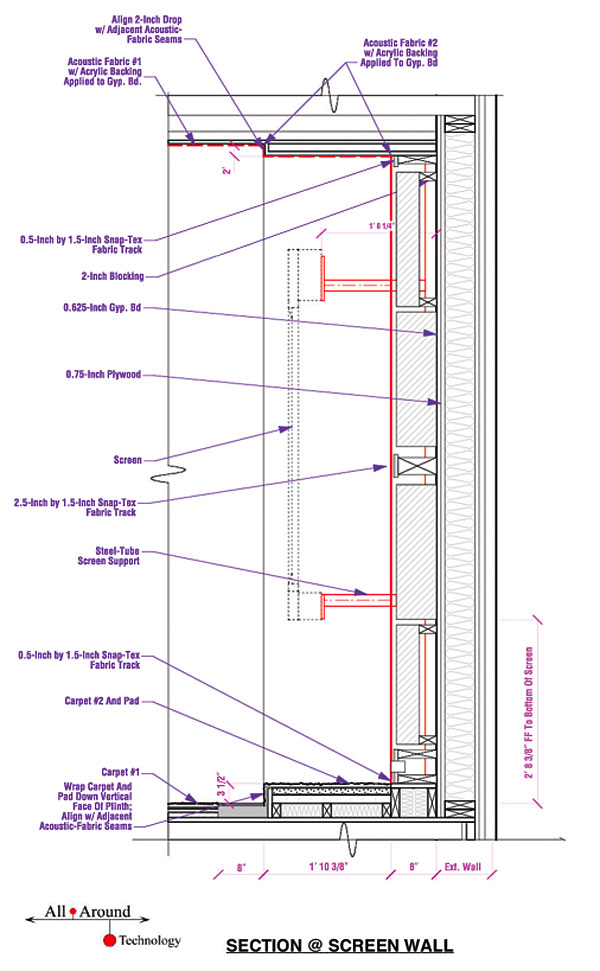

- Log in or register to post comments




































































